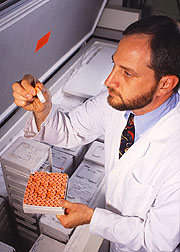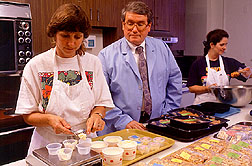Not All Table Spreads "Butter Up" Blood Cholesterol
|
|
The 46 volunteers in a study at the Agricultural Research Service Beltsville (Maryland) Human Nutrition Research Center could tell the difference between butter and those other spreads.
But they couldn't distinguish between the margarines with and without trans fats. Only the dietitians who prepared the meals knew for sure. Researchers and volunteers were kept in the dark during the 15-week study, to ensure objectivity.
On weekdays, the volunteers ate breakfast and dinner in the Beltsville center dining rooms and carried lunch to their jobs. Weekend meals were carried home in a cooler for later warming. Volunteer Sandra Laase says, "You had to eat everything they gave you--and you couldn't eat anything extra."
According to Vickie Lopez, a veteran of several studies at the Beltsville center, "The study got hard when there were holiday luncheons. We had to carry our brown bags with our prepared lunch and eat that." But the researchers agreed to let the volunteers eat their own dinner on Thanksgiving and Christmas, as long as they used the butter or margarine provided and recorded what they ate.
The question asked by researchers Joseph T. Judd, David J. Baer, and Beverly A. Clevidence was: "Do differences in blood lipids show up with minor changes in fatty acid profiles among the three spreads?" says study leader Judd. "Butter is the standard. Americans desire hardened fats in their spreads and baked goods."
They also want fats that reduce risk of cardiovascular disease. So the food industry partially hydrogenates vegetable oils for consumer acceptance. And that process produces trans fatty acids, or trans fats.
Scientists have been concerned about their health effects for nearly as long as oils have been hydrogenated. Until 1990, the evidence leaned toward no adverse effects.
Then a Dutch study showed that high intakes of trans fats did indeed raise cholesterol, says Judd--especially the artery-damaging LDL cholesterol. Four years later, Judd, Baer, Clevidence, and colleagues reported similar effects on blood lipids when volunteers in an earlier study at the Beltsville center consumed as little as one-third the trans fats fed in the Dutch study.
It's possible to harden products such as table spreads without hydrogenation, says Judd. The margarines in this study were specially made by Lipton in Baltimore, Maryland.
Their composition is compared in the chart on page 15.
Trans-Free Fats Look Best
The 23 men and 23 women volunteers consumed each spread for 5 weeks as part of a typical U.S. diet. That is to say, 35 percent of total calories were fat, 15 percent were protein, and 50 percent carbohydrates.
Most Americans don't eat as much butter or margarine as fed in this study, says Baer, noting that the spreads accounted for 8 percent of total calories. That's about 2 to 3 tablespoons each day. "We wanted to be able to see small changes in blood lipids," he says.
Analysis of the volunteers' blood samples showed a stairstep effect from the three spreads:
· Butter evoked the highest LDL and total cholesterol levels.
· After eating the trans-fat margarine for 5 weeks, the volunteers' total cholesterol was 3.5 percent lower than with butter, and their LDL was down 5.4 percent.
· Five weeks of consuming the non-trans-fat margarine hardened with the innocuous stearic acid produced the lowest levels. Compared to butter, total cholesterol was down 4.7 percent and LDL was 6.7 percent lower.
"There's only one conclusion that can be reached," says Judd. "You limit trans fats in the diet where you can. But don't get overly concerned to the point where you substitute saturated fats for trans fats. Saturated fats average about 12 percent of the total calories in the diet and are a major dietary factor in cardiovascular disease risk.
"If it's tub margarine, which softens at room temperature, and the primary fat on the label is liquid vegetable oil, it's okay," says Judd, "even if it contains some trans fats.
"Even better," he notes, "may be some of the economical trans-free margarines that are coming on the market." More of these will follow as consumers demand alternatives.
Chemically speaking, trans fatty acids are monounsaturated fatty acids like oleic acid--the principal fatty acid in olive and canola oils. Healthwise, they are not equal. The body perceives trans fats more like the cholesterol-raising saturated fats. Vegetable oils high in oleic acid, on the other hand, tend to reduce blood cholesterol when they replace saturated fats.
Baer says that on average, 2 to 3 percent of total calories in the American diet comes from trans fats. And only about 10 percent of that intake is contributed by the naturally occurring trans fats in red meat, milk, and other dairy products. The rest comes mostly from partially hydrogenated oils in margarines, in shortening used in baked goods such as cookies, pastries, and icings, and in restaurant fried foods.
Noting that she normally eats junk food, Lopez says, "I've always felt healthier when I've done a study because I eat better."
Laase concurs. "I was probably the healthiest when I was on the controlled diet," she says. "And we took no vitamins. It's probably the only time I ate breakfast." Laase says she enjoyed the study, noting that the discipline got difficult only toward the end.
One Fatty Acid at a Time
With the table spread study under their belts, Judd, Baer, and colleagues wanted to tease apart the effects of individual fatty acids that raise, lower, or have no effect on blood lipids. As each table spread was changed, several fatty acids changed in the diets, explained Baer. The follow-up study varied levels of one fatty acid or mixture of them at a time.
Over the course of 7 months, the researchers tested five diets differing in fatty acids and one with extra carbohydrates. Two fatty acids--oleic and stearic--and extra carbohydrates served as controls. The other three fatty acids tested were trans fats, trans fats plus stearic acid, and a combination of three cholesterol-raising saturated fats. When results are finalized, they will help clarify the evidence needed for expert panels to reach consensus on the remaining dietary fat questions.
To make informed choices, "the public needs clear health messages from organizations like the American Heart Association, National Institutes of Health, and the U.S. Department of Agriculture," says Judd.--By Judy McBride, Agricultural Research Service Information Staff.
Joseph T. Judd and David J. Baer are at the USDA-ARS Diet and Human Performance Laboratory, Beltsville Human Nutrition Research Center, Bldg. 308, 10300 Baltimore Ave., Beltsville, MD 20705-2350; fax for both (301) 504-9098; [Judd] phone (301) 504-9014. [Baer] phone (301) 504-8719.
"Not All Table Spreads "Butter Up" Blood Cholesterol" was published in the September 1998 issue of Agricultural Research magazine. Click here to see this issue's table of contents.








